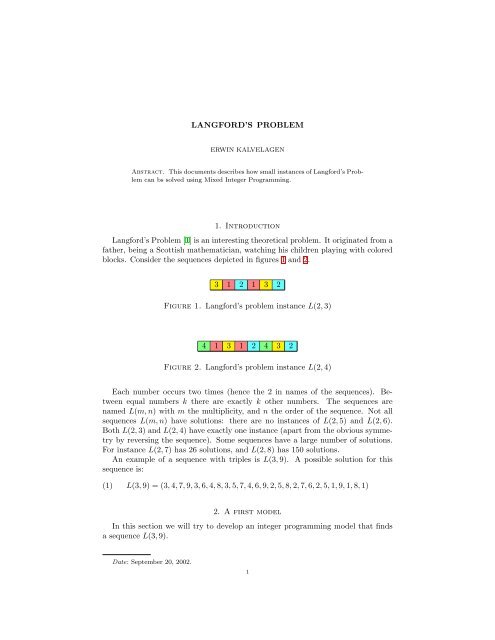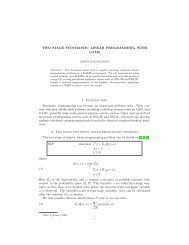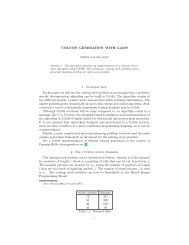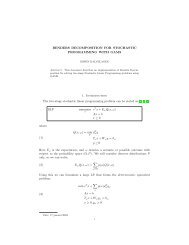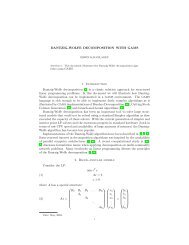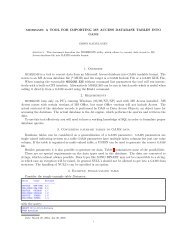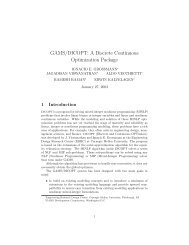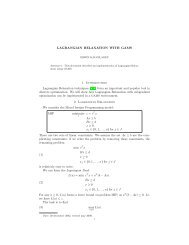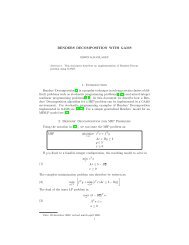Langford's Problem - Amsterdam Optimization Modeling Group
Langford's Problem - Amsterdam Optimization Modeling Group
Langford's Problem - Amsterdam Optimization Modeling Group
Create successful ePaper yourself
Turn your PDF publications into a flip-book with our unique Google optimized e-Paper software.
LANGFORD’S PROBLEM<br />
ERWIN KALVELAGEN<br />
Abstract. This documents describes how small instances of Langford’s <strong>Problem</strong><br />
can bs solved using Mixed Integer Programming.<br />
1. Introduction<br />
Langford’s <strong>Problem</strong> [1] is an interesting theoretical problem. It originated from a<br />
father, being a Scottish mathematician, watching his children playing with colored<br />
blocks. Consider the sequences depicted in figures 1 and 2.<br />
3 1 2 1 3 2<br />
Figure 1. Langford’s problem instance L(2, 3)<br />
4 1 3 1 2 4 3 2<br />
Figure 2. Langford’s problem instance L(2, 4)<br />
Each number occurs two times (hence the 2 in names of the sequences). Between<br />
equal numbers k there are exactly k other numbers. The sequences are<br />
named L(m, n) with m the multiplicity, and n the order of the sequence. Not all<br />
sequences L(m, n) have solutions: there are no instances of L(2, 5) and L(2, 6).<br />
Both L(2, 3) and L(2, 4) have exactly one instance (apart from the obvious symmetry<br />
by reversing the sequence). Some sequences have a large number of solutions.<br />
For instance L(2, 7) has 26 solutions, and L(2, 8) has 150 solutions.<br />
An example of a sequence with triples is L(3, 9). A possible solution for this<br />
sequence is:<br />
(1) L(3, 9) = (3, 4, 7, 9, 3, 6, 4, 8, 3, 5, 7, 4, 6, 9, 2, 5, 8, 2, 7, 6, 2, 5, 1, 9, 1, 8, 1)<br />
2. A first model<br />
In this section we will try to develop an integer programming model that finds<br />
a sequence L(3, 9).<br />
Date: September 20, 2002.<br />
1
2 ERWIN KALVELAGEN<br />
2.0.1. Model langford.gms. 1<br />
$ontext<br />
Langford’s <strong>Problem</strong> L(3,9)<br />
Erwin Kalvelagen, July 2002<br />
References:<br />
http://www.lclark.edu/~miller/langford.html<br />
$offtext<br />
set n ’number (0..9)’ /n1*n9/;<br />
set m ’each number occurs three times’ /m1*m3/;<br />
alias (n,nn);<br />
alias (m,mm);<br />
set notfirst(m);<br />
notfirst(m)$(ord(m)>1)=yes;<br />
variable x(n,m) ’locations (1..27)’;<br />
x.lo(n,m) = 1;<br />
x.up(n,m) = card(n)*card(m);<br />
binary variable P(n,m,nn,mm) ’Permutation matrix’;<br />
free variable dummy<br />
equations<br />
unique(n,m)<br />
permutation1(n,m)<br />
permutation2(n,m)<br />
triplets(n,m)<br />
objective<br />
summation<br />
;<br />
’objective variable’;<br />
’x should be unique’<br />
’Permutation matrix’<br />
’Permutation matrix’<br />
’make sure spacing is correct’<br />
’dummy objective function’<br />
’extra constraint’<br />
*<br />
* Permutation matrix makes sure x’s are unique<br />
*<br />
parameter v(n,m);<br />
v(n,m) = ord(n)+card(n)*(ord(m)-1);<br />
display v;<br />
unique(n,m).. x(n,m) =e= sum((nn,mm),P(n,m,nn,mm)*v(nn,mm));<br />
permutation1(n,m).. sum((nn,mm), P(n,m,nn,mm)) =e= 1;<br />
permutation2(n,m).. sum((nn,mm), P(nn,mm,n,m)) =e= 1;<br />
*<br />
* place triples with correct amount of space between them<br />
*<br />
triplets(n,notfirst(m)).. x(n,m) =e= x(n,m-1) + ord(n) + 1;<br />
*<br />
* extra constraint sum x = 1 + 2 + ... + 27<br />
*<br />
summation.. sum((n,m), x(n,m)) =e= 0.5*(card(n)*card(m))*(card(n)*card(m)+1);<br />
*<br />
* dummy objective<br />
*<br />
objective.. dummy =e= 0;<br />
$ontext<br />
1 http://amsterdamoptimization.com/models/langford.gms
LANGFORD’S PROBLEM 3<br />
*<br />
* this can be used to test the formulation.<br />
* test solution 347936483574692582762519181<br />
*<br />
parameter solution(n,m) /<br />
n3.m1 1<br />
n4.m1 2<br />
n7.m1 3<br />
n9.m1 4<br />
n3.m2 5<br />
n6.m1 6<br />
n4.m2 7<br />
n8.m1 8<br />
n3.m3 9<br />
n5.m1 10<br />
n7.m2 11<br />
n4.m3 12<br />
n6.m2 13<br />
n9.m2 14<br />
n2.m1 15<br />
n5.m2 16<br />
n8.m2 17<br />
n2.m2 18<br />
n7.m3 19<br />
n6.m3 20<br />
n2.m3 21<br />
n5.m3 22<br />
n1.m1 23<br />
n9.m3 24<br />
n1.m2 25<br />
n8.m3 26<br />
n1.m3 27<br />
/;<br />
x.fx(n,m) = solution(n,m);<br />
$offtext<br />
*<br />
* priorities<br />
*<br />
P.prior(n,m,nn,mm) = 2*card(n)-ord(n)-ord(nn);<br />
*<br />
* write Cplex option file<br />
*<br />
file opt /cplex.opt/;<br />
putclose opt ’mipemphasis 1’/;<br />
model langford /all/;<br />
*<br />
* turn on option file reading and usage of priorities<br />
*<br />
langford.prioropt=1;<br />
langford.optfile=1;<br />
*<br />
* select Cplex as MIP solver<br />
*<br />
option mip=cplex;<br />
option iterlim=100000000;<br />
option reslim=100000;<br />
solve langford minimizing dummy using mip;<br />
option x:0:1:1;<br />
display x.l;<br />
There are some remarks we can make about this model. First note that the<br />
permutation is now a four dimensional structure as the decision variable that must
4 ERWIN KALVELAGEN<br />
be unique, is two dimensional. We can add the constraint ∑ x i = 1 + 2 + · · · +<br />
27. This constraint is automatically valid for an integer solution, but it helps the<br />
optimization algorithm when there are still fractional solutions. We have added<br />
priorities that tell the solver to place first the high numbered triples, as they are<br />
widely spaced, and are difficult to “squeeze in.” Priorities are especially important<br />
when the solver does not receive any good pricing signals, as this model does not<br />
have a proper objective function that can help to distinguish solutions. When<br />
solving this model with Cplex we can add the option mipemphasis 1 (emphasis<br />
on finding a feasible integer solution) as the first integer solution is immediately<br />
(proven) optimal, given the dummy objective function. Note that this also implies<br />
that we don’t have to set an OPTCR value. A simple way to check the solution given<br />
in equation (1) is also provided. It is commented out, but a few simple edits will<br />
enable it.<br />
The solution found with Cplex is as follows:<br />
---- 132 VARIABLE x.L locations (1..27)<br />
m1 m2 m3<br />
n1 23 25 27<br />
n2 18 21 24<br />
n3 3 7 11<br />
n4 10 15 20<br />
n5 2 8 14<br />
n6 5 12 19<br />
n7 1 9 17<br />
n8 4 13 22<br />
n9 6 16 26<br />
This is different than the solution mentioned in equation (1). Indeed, there are<br />
three different solutions for L(3, 9).<br />
3. A second model<br />
This is not the only possible formulation (which is a familiar theme). For instance<br />
we can calculate for all combinations (i, j), (i ′ , j ′ ):<br />
(2) d(i, j, i ′ , j ′ ) = x(i, j) − x(i ′ , j ′ )<br />
and then require that |d(i, j, i ′ , j ′ )| ≥ 1 for all (i, j) ≠ (i ′ , j ′ ). The minimum distance<br />
requirement can be linearized by saying d(i, j, i ′ , j ′ ) ≤ −1 ∨ d(i, j, i ′ , j ′ ) ≥ 1. This<br />
“or”-constraint can be modeled easily using binary variables δ i,j,i′ ,j ′:<br />
(3)<br />
d(i, j, i ′ , j ′ ) ≥ 1 − δ i,j,i′ ,j ′M<br />
d(i, j, i ′ , j ′ ) ≤ −1 + (1 − δ i,j,i′ ,j ′)M<br />
We need to choose an appropriate value for M. The following model implements<br />
this.<br />
3.0.2. Model langford2.gms. 2<br />
$ontext<br />
Langford’s <strong>Problem</strong> L(3,9),<br />
alternative formulation<br />
Erwin Kalvelagen, July 2002<br />
References:<br />
2 http://amsterdaomoptimization.com/models/langford2.gms
LANGFORD’S PROBLEM 5<br />
http://www.lclark.edu/~miller/langford.html<br />
$offtext<br />
set n ’number (0..9)’ /n1*n9/;<br />
set m ’each number occurs three times’ /m1*m3/;<br />
alias (n,nn);<br />
alias (m,mm);<br />
set notfirst(m);<br />
notfirst(m)$(ord(m)>1)=yes;<br />
integer variable x(n,m) ’locations’;<br />
free variable dist(n,m,nn,mm) ’distance between two locations’;<br />
binary variable delta(n,m,nn,mm) ’used in |distance| >= 1’;<br />
scalar mn ’m times n’;<br />
mn = card(m)*card(n);<br />
x.lo(n,m)=1;<br />
x.up(n,m)=mn;<br />
free variable dummy<br />
’objective variable’;<br />
equations<br />
triplets(n,m) ’make sure spacing is correct’<br />
objective<br />
’dummy objective function’<br />
summation<br />
’extra constraint’<br />
distance<br />
’calculate distances between x(i,j) and x(p,q)’<br />
mindist1 ’abs(distance) >= 1’<br />
mindist2 ’abs(distance) >= 1’<br />
;<br />
*<br />
* distance measure approach<br />
*<br />
set comb(n,m,nn,mm);<br />
comb(n,m,nn,mm)$((ord(n)ord(nn)) or (ord(m)ord(mm))) = yes;<br />
distance(comb(n,m,nn,mm)).. dist(comb) =e= x(n,m) - x(nn,mm);<br />
mindist1(comb(n,m,nn,mm)).. dist(comb) =g= 1 - delta(comb)*mn;<br />
mindist2(comb(n,m,nn,mm)).. dist(comb) =l= -1 + (1-delta(comb))*mn;<br />
dist.lo(comb) = -mn+1;<br />
dist.up(comb) = mn-1;<br />
*<br />
* place triples<br />
*<br />
triplets(n,notfirst(m)).. x(n,m) =e= x(n,m-1) + ord(n) + 1;<br />
*<br />
* extra constraint<br />
*<br />
summation.. sum((n,m), x(n,m)) =e= 0.5*mn*(mn+1);<br />
*<br />
* dummy objective<br />
*<br />
objective.. dummy =e= 0;<br />
$ontext<br />
*<br />
* this can be used to test the solution<br />
* test solution 347936483574692582762519181<br />
*
6 ERWIN KALVELAGEN<br />
parameter solution(n,m) /<br />
n3.m1 1<br />
n4.m1 2<br />
n7.m1 3<br />
n9.m1 4<br />
n3.m2 5<br />
n6.m1 6<br />
n4.m2 7<br />
n8.m1 8<br />
n3.m3 9<br />
n5.m1 10<br />
n7.m2 11<br />
n4.m3 12<br />
n6.m2 13<br />
n9.m2 14<br />
n2.m1 15<br />
n5.m2 16<br />
n8.m2 17<br />
n2.m2 18<br />
n7.m3 19<br />
n6.m3 20<br />
n2.m3 21<br />
n5.m3 22<br />
n1.m1 23<br />
n9.m3 24<br />
n1.m2 25<br />
n8.m3 26<br />
n1.m3 27<br />
/;<br />
x.fx(n,m) = solution(n,m);<br />
$offtext<br />
x.prior(n,m) = 2*card(n) - 2*ord(n);<br />
delta.prior(n,m,nn,mm) = 2*card(n)-ord(n)-ord(nn);<br />
*<br />
* write Cplex option file<br />
*<br />
file opt /cplex.opt/;<br />
putclose opt ’mipemphasis 1’/;<br />
model langford /all/;<br />
*<br />
* turn on option file reading and usage of priorities<br />
*<br />
langford.prioropt=1;<br />
langford.optfile=1;<br />
*<br />
* select Cplex as MIP solver<br />
*<br />
*option mip=cplex;<br />
option iterlim=1000000;<br />
solve langford minimizing dummy using mip;<br />
display x.l;<br />
The results with Cplex 7.5 are displayed in table 1. In this case the model with<br />
more variables and equations performs better than the smaller model. This is not<br />
unusual in integer programming: it is difficult to predict performance based on the<br />
size of the model.<br />
In [2] a constraint programming approach to solve this problem is discussed.
LANGFORD’S PROBLEM 7<br />
langford.gms langford2.gms<br />
equations 101 2126<br />
variables 757 1432<br />
discrete variables 729 729<br />
resource usage 370 80<br />
iterations 3182053 258489<br />
nodes 47520 11339<br />
Table 1. Results for the Langford problems<br />
References<br />
1. C. Dudley Langford, <strong>Problem</strong>, Mathematical Gazette 42 (1958), 228.<br />
2. Barbara M. Smith, Modelling a permutation problem, Tech. Report 2000.18, University of<br />
Leeds, School of Computer Studies, June 2000.<br />
<strong>Amsterdam</strong> <strong>Optimization</strong> <strong>Modeling</strong> <strong>Group</strong> LLC, Washington DC<br />
E-mail address: erwin@amsterdamoptimization.com


